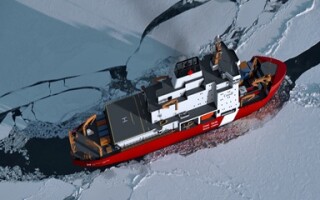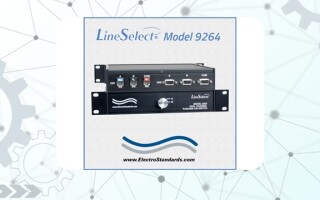New capabilities on the way for airborne maritime surveillance radars
StoryJanuary 29, 2014
Airborne maritime surveillance radars play a central role in the global homeland defense of more than 315,000 miles of worldwide coastline. While considered state-of-the-art, these radars continue to evolve to meet military customers' needs for persistent surveillance, automation, and continued tracking of targets as they move from sea to land.
From a mission standpoint, the traditional role for airborne maritime surveillance radars was anti-surface warfare, or basically detecting small targets on the ocean surface in heavy sea states. This capability was critical during the Cold War, at a time when the US Navy needed to quickly detect small targets such as Russian periscopes.
After the Cold War, the land-sea border known as the littoral zone has emerged as an area of intense interest. Within the littoral zone, the challenge for airborne maritime surveillance involves looking at thousands of targets in the water because anything floating on the surface – including debris and trash – appears as a target. This can make it challenging for radar operators and mission commanders to quickly make sense of a complex tactical picture and zero in on actual targets.
Industry leaders Telephonics Corp. (Farmingdale, NY; www.telephonics.com) and Raytheon (McKinney, TX; www.raytheon.com) are addressing the littoral zone issue and many other challenges by continuing to enhance the capabilities of their airborne maritime surveillance radars.
Capabilities requested by military customers
What types of capabilities are military customers requesting for airborne maritime surveillance radars today? For starters, airborne maritime surveillance radar used in a military application must be military grade and able to survive the airborne environment.
“For maritime surveillance, one of the key capabilities is the ability to detect small targets at long ranges in heavy sea states,” says Joseph Battaglia, president and CEO of Telephonics Corp. “Heavy seas can obscure relatively small targets, so it’s important to know how to extract the target of interest from the background sea clutter, which interferes with the ability to detect the target.”
The military often needs to identify targets of interest, and Inverse Synthetic Aperture Radar (ISAR) imaging is one of Telephonics’ strengths. “Telephonics’ images have been referred to as ‘eyewatering,’ because of their high resolution and crispness. These images can help identify a battleship from a cargo ship from a pleasure yacht. Whatever the target is, you’ll see a physical image of it on the radar display, as opposed to the classic radar return, which would be a dot on the screen,” Battaglia says.
Military customers also want to detect targets with an Identification Friend or Foe (IFF) capability. IFF systems are typically separate systems on a platform. “Telephonics has fully integrated the IFF function into our radar systems, which along with saving size, weight, and wiring on aircraft, actually performs better than two separate systems that are required to communicate,” Battaglia says.
Yet another important capability? The Ocean Surveillance Initiative (OSI), in which the automatic identification system (AIS) works with the OSI to provide a complete operating picture of the field of regard.
Adding OSI and AIS functions to maritime surveillance radars “enables persistent surveillance and a littoral capability, providing the operator a common operating picture (COP),” Battaglia explains. “Submarines are probably the worst threat to the fleet. Some of Telephonics’ radars provide a periscope detection mode and are deployed on fixed-wing aircraft, helicopter platforms, and UAVs [Unmanned Aerial Vehicles] to ensure the fleet is well protected.” (See Figure 1).
Figure 1: The AN/APS-153(V) maritime radar from Telephonics Corp. is found on the U.S. Navy’s MH-60R helicopter. Photo courtesy of Telephonics.
(Click graphic to zoom by 1.9x)
As part of Raytheon’s recent XMC (eXpanded Mission Capability) upgrade to its SeaVue radar, the company enhanced its radar system to automatically correlate radar and AIS tracks. “The radar presents a single track to reduce clutter on the display and provide additional information to the operator,” says Brad Hopper, business development director in Raytheon’s Intelligence, Surveillance, and Reconnaissance systems mission area.
Although AIS is typically on larger ships – 300 tons or more – this capability is particularly useful if a small target is being tracked in a shipping lane with lots of large ships. With the click of a button, according to Hopper, the operator is able to remove those larger targets from the display and concentrate on the target of interest.
Out of concern about hijacked ships spoofing AIS, the Raytheon radar can provide an automatic length estimation of radar-detected ships. “If you’re far enough away and can’t get eyes on with electro-optics, now you can check it against the length AIS is sending to protect against spoofing,” Hopper says.
Persistent surveillance’s influence on radar design
Persistent surveillance is influencing the design of airborne maritime surveillance radars in several ways, in particular, automation.
“Historically an operator spent more time operating the radar than understanding what’s on the surface of the ocean. A significant amount of automation was added during Raytheon’s XMC upgrade to SeaVue to help out in this area,” Hopper notes.
For example, if you have a critical piece of infrastructure such as a power plant or oil platform and don’t want anything (such as a vessel) getting close to it, you can use SeaVue XMC software to set up an exclusion zone so the operator is automatically alerted if anything moves in or out of it. “This ability to automate the process and help the operator understand what’s happening in the littoral environment is significant. Customers say this capability with SeaVue XMC has reduced their operator workload by 50 percent, so now they can spend time doing the real mission and not just operating the radar,” Hopper says.
Being able to do precision tracking on each one of these targets also enables persistent surveillance. “One of the problems with long-term surveillance of a certain area is that small targets of interest tend to lump together and targets that are trying to hide from you will purposely get into a fishing fleet or cross into a transit lane to avoid detection,” Hopper adds. “We’ve added precision tracking into the SeaVue XMC to help with persistent surveillance and to ensure we maintain track on that target no matter how small it is or how it’s maneuvering.”
Sidebar 1
(Click graphic to zoom by 1.9x)
Leveraging COTS signal-processing solutions
Are new airborne maritime surveillance radar systems leveraging Commercial-Off-The-Shelf (COTS) signal-processing solutions to meet performance requirements and enable open architecture designs? Absolutely.
“As far as signal processing is concerned, there are many COTS solutions you can buy off the shelf,” Battaglia says. “High-speed, high-throughput processors are used to accomplish the system performance we desire. The key to achieving the requisite performance is primarily driven by the algorithms and software embedded on these processors. Telephonics’ algorithms are optimized to differentiate between sea clutter and targets.”
Raytheon also takes advantage of high technology in the commercial world whenever it can for its radar products. “Some of Raytheon’s airborne maritime radars use COTS products, such as the Freescale PowerPC G4,” Hopper says. “In this case, these are put onto a ruggedized board by a supplier like Mercury Systems, and then we buy the board. We use this kind of processor because as they improve, we want to be able to upgrade without major impact to customers.”
However, “you should use care when selecting COTS components for this application because they need to be able to survive the fairly severe environment of an airborne platform,” Hopper cautions.
New capabilities on the way
Expect the trend toward reducing size, weight, and power consumption for airborne maritime surveillance radars to continue, but also watch for other interesting capabilities to emerge within the next few years.
Raytheon is currently is adding a ground-moving target indicator (GMTI) capability, based on demand from international customers. For homeland security missions, for example, if you’re tracking someone bringing illegal drugs in on a vessel, you can track them right up the coastline, but then they can transfer cargo to a truck and just drive away – the maritime mode can’t continue to track them. “GMTI mode will enable continued tracking, so you’ll be able to get land forces vectored there to intercept them,” Hopper says. “Raytheon will demonstrate GTMI capabilities for SeaVue XMC during 2014.”
Active Electronic Scanned Array (AESA) radars using conformal antennae offer next-generation capabilities for maritime surveillance. Rather than using a rotating antenna, there are a number of ways to implement AESA radar onto a platform – in the nose of the craft, under the belly, or incorporated into the aircraft’s skin as a panel.
“AESA designs eliminate moving parts, increase reliability, and offer ‘graceful degradation’ of a system when failures occur,” Battaglia notes.
It may be a while, however, before AESA technology is ready to compete in the airborne maritime radar market with other systems for the same size, weight, performance, and price point. High-performance AESA systems tend to be significantly larger and can be liquid cooled, which makes them bulky and expensive – but this is all likely to change at some point in the future.









